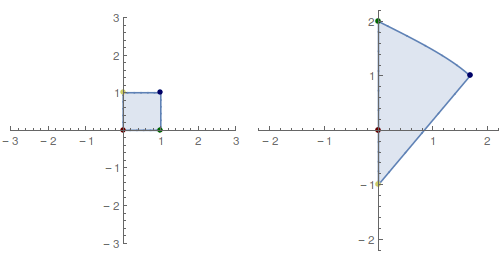Diferenças entre edições de "Transformação de um quadrado"
| (Há uma revisão intermédia de outro utilizador que não está a ser apresentada) | |||
| Linha 23: | Linha 23: | ||
Indique qual das seguintes funções pode corresponder a essa transformação. | Indique qual das seguintes funções pode corresponder a essa transformação. | ||
| − | A)\(\pmb{\text{f}}\left(\begin{array}{c}x\\y\\\end{array}\right)=\left(\begin{array}{c}2x\sin(y)\\2x-y\\\end{array}\right)\) | + | A) \(\pmb{\text{f}}\left(\begin{array}{c}x\\y\\\end{array}\right)=\left(\begin{array}{c}2x\sin(y)\\2x-y\\\end{array}\right)\) |
| − | B)\(\pmb{\text{f}}\left(\begin{array}{c}x\\y\\\end{array}\right)=\left(\begin{array}{c}y-2x\\2x-y\\\end{array}\right)\) | + | B) \(\pmb{\text{f}}\left(\begin{array}{c}x\\y\\\end{array}\right)=\left(\begin{array}{c}y-2x\\2x-y\\\end{array}\right)\) |
| − | C)\(\pmb{\text{f}}\left(\begin{array}{c}x\\y\\\end{array}\right)=\left(\begin{array}{c}2x\sin(y)\\2x-2y\\\end{array}\right)\) | + | C) \(\pmb{\text{f}}\left(\begin{array}{c}x\\y\\\end{array}\right)=\left(\begin{array}{c}2x\sin(y)\\2x-2y\\\end{array}\right)\) |
| − | D)\(\pmb{\text{f}}\left(\begin{array}{c}x\\y\\\end{array}\right)=\left(\begin{array}{c}-x^2+xy+y^2\\-2y\sin(x)\\\end{array}\right)\) | + | D) \(\pmb{\text{f}}\left(\begin{array}{c}x\\y\\\end{array}\right)=\left(\begin{array}{c}-x^2+xy+y^2\\-2y\sin(x)\\\end{array}\right)\) |
| − | Para obter o zip que contém as instâncias deste exercício clique aqui | + | Para obter o zip que contém as instâncias deste exercício clique aqui[https://drive.tecnico.ulisboa.pt/api/drive/file/1695923671482848/download] |
Se deseja obter o código fonte que gera os exercícios contacte miguel.dziergwa@ist.utl.pt | Se deseja obter o código fonte que gera os exercícios contacte miguel.dziergwa@ist.utl.pt | ||
Edição atual desde as 11h10min de 3 de abril de 2018
Metadata
- CONTEXTO : Primeiro ciclo universitário
- AREA: Matemática
- DISCIPLINA: Calculo Diferencial e Integral 2
- ANO: 1
- LINGUA: pt
- AUTOR: Ana Moura Santos e Miguel Dziergwa
- MATERIA PRINCIPAL: Funções de \(R^n\) em \(R^m\): limite e continuidade
- DESCRICAO: Transformação de um quadrado
- DIFICULDADE: *
- TEMPO MEDIO DE RESOLUCAO: 10 mn
- TEMPO MAXIMO DE RESOLUCAO: 15 mn
- PALAVRAS CHAVE: transformação, função ou aplicação não-linear em \(R^2\)
Considere a transformação do quadrado unitário da esquerda para a figura da direita.
Indique qual das seguintes funções pode corresponder a essa transformação.
A) \(\pmb{\text{f}}\left(\begin{array}{c}x\\y\\\end{array}\right)=\left(\begin{array}{c}2x\sin(y)\\2x-y\\\end{array}\right)\)
B) \(\pmb{\text{f}}\left(\begin{array}{c}x\\y\\\end{array}\right)=\left(\begin{array}{c}y-2x\\2x-y\\\end{array}\right)\)
C) \(\pmb{\text{f}}\left(\begin{array}{c}x\\y\\\end{array}\right)=\left(\begin{array}{c}2x\sin(y)\\2x-2y\\\end{array}\right)\)
D) \(\pmb{\text{f}}\left(\begin{array}{c}x\\y\\\end{array}\right)=\left(\begin{array}{c}-x^2+xy+y^2\\-2y\sin(x)\\\end{array}\right)\)
Para obter o zip que contém as instâncias deste exercício clique aqui[1]
Se deseja obter o código fonte que gera os exercícios contacte miguel.dziergwa@ist.utl.pt
